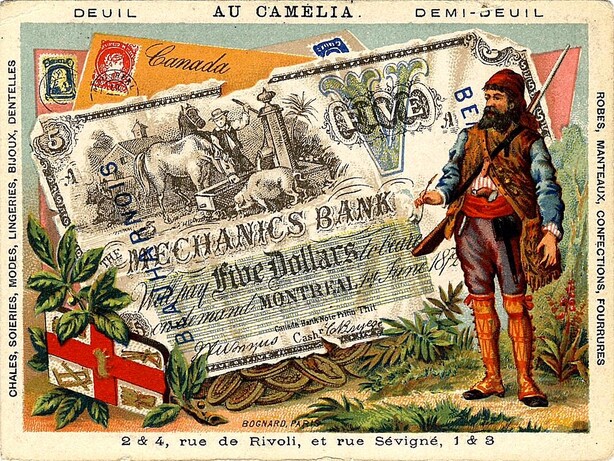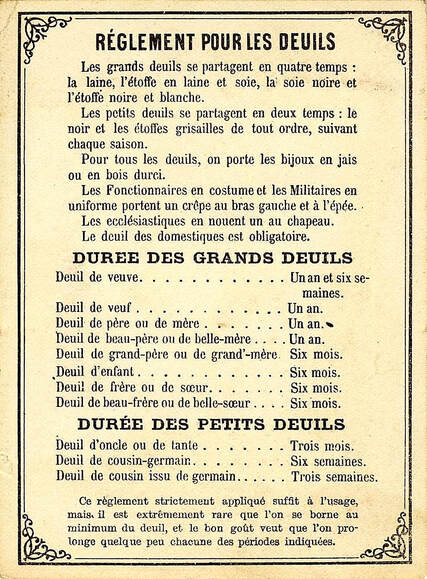Appendix I
The “Au Camélia” Trade Card
Apart from the store’s name, address and specialties on the border of the “Au Camélia” trade card, the composition is all Canadian (fig. 11). The centre piece is a five-dollar bill from the Mechanics Bank of Montreal. On the right, appears a coureur de bois or Canadian woodsman in traditional dress; on the lower left, a truncated version of the Canada Company shield is displayed in reverse. Several letters with Victorian stamps, one of which is distinctly marked Canada, rise above the banknote, while a pile of coins, one with the head of Queen Victoria, nestles below. The abundant plants are featured as being native to Canada. The trade card is obviously intended for the Canadian market and more particularly for Montreal which is predominantly French speaking and the largest city in Canada at the time.
Fig. 11. “Au Camélia” trade card with a Canadian theme, chromolithographed c. 1872 by Jean Bognard of Paris, see fig. 6.
Fig. 12. The back of figure 11. “The regulations for mourning differentiate between long periods of mourning “grands deuils” and short periods of mourning “petits deuils,” which vary according to the degree of kingship of the deceased to the mourner, each case requiring different attire.
The blue overprint “Beauharnois” probably means that the banknote was issued at the Beauharnois branch of the bank or cashed there. [5] The banknote is signed J.H. Menzies and C.J. Brydges, respectively cashier and president of the bank. [6] Under “MONTREAL,” is the inscription “Canada Bank Note Printing Tint,” which is found on banknotes issued by many Canadian Banks and refers to the actual colour tint printed on the note. The Bank of Canada Currency Museum holds at least one five dollar note from the Mechanics bank of Montreal. It is printed by the British American Bank Note Company operating in Montreal and Ottawa. The copyright belongs to the Canada Bank Note Company. [7] Bognard cards with the same image as figure 11were not just made for “Au Camélia”, but also for other companies who wanted to advertise in Canada.
The chromolithographed image was printed by Jean Bognard of Paris, a printer and lithographer who specialized in publicity material and produced this type of cards for countries all over the world. The banknotes have a similar composition from one country to another: a traditional costume, the country’s shield of arms, letters with stamps, coins and native vegetation. A first printing was done with the central image only, leaving the margins and back of the card blank. A subsequent printing added particulars regarding a company and its products in the margins and on the back. Some cards with only the image and nothing in the margin or on the back have survived.
The designs followed a standard recipe, but some research was still required to choose a banknote and costume typical of a country. Obviously the research on the emblem chosen to represent Canada was less than adequate (see the comments above fig. 6). Collectors and dealers usually date the series of cards from 1890 or near the end of the nineteenth century. The banknote on the Canadian card is dated 1872 and its issuer, the Mechanics Bank of Montreal, failed in 1879. Other cards in the same series that have identifiable banknote dates range from 1870 for Switzerland and 1879 for the Bank of England.
The store “Au Camélia” was owned by A. Chapu, and located at the corner of Rivoli and Sévigné Streets in front of St. Paul Church in Paris. It sold all kinds of clothing and jewelry, but was especially known for mourning attire. Signs on the façade of its store read “Grande maison de deuil” meaning “Great House of Mourning.” Some of its trade cards, such as the one illustrated here (figs. 11-12), contain the notion of deuil (full mourning) and demi-deuil (half mourning). On the back of the card (fig. 12), the terms grand deuil and petit deuil are used to differentiate between the two types of mourning which are determined by the degree of kinship calling for different mourning periods. For example the period for a widow is one year and six weeks, while that for an uncle or aunt is three months. The card also advises that the proposed mourning periods are a minimum, since they last a little longer traditionally. Appropriate attire is also recommended for the various levels of mourning.
The chromolithographed image was printed by Jean Bognard of Paris, a printer and lithographer who specialized in publicity material and produced this type of cards for countries all over the world. The banknotes have a similar composition from one country to another: a traditional costume, the country’s shield of arms, letters with stamps, coins and native vegetation. A first printing was done with the central image only, leaving the margins and back of the card blank. A subsequent printing added particulars regarding a company and its products in the margins and on the back. Some cards with only the image and nothing in the margin or on the back have survived.
The designs followed a standard recipe, but some research was still required to choose a banknote and costume typical of a country. Obviously the research on the emblem chosen to represent Canada was less than adequate (see the comments above fig. 6). Collectors and dealers usually date the series of cards from 1890 or near the end of the nineteenth century. The banknote on the Canadian card is dated 1872 and its issuer, the Mechanics Bank of Montreal, failed in 1879. Other cards in the same series that have identifiable banknote dates range from 1870 for Switzerland and 1879 for the Bank of England.
The store “Au Camélia” was owned by A. Chapu, and located at the corner of Rivoli and Sévigné Streets in front of St. Paul Church in Paris. It sold all kinds of clothing and jewelry, but was especially known for mourning attire. Signs on the façade of its store read “Grande maison de deuil” meaning “Great House of Mourning.” Some of its trade cards, such as the one illustrated here (figs. 11-12), contain the notion of deuil (full mourning) and demi-deuil (half mourning). On the back of the card (fig. 12), the terms grand deuil and petit deuil are used to differentiate between the two types of mourning which are determined by the degree of kinship calling for different mourning periods. For example the period for a widow is one year and six weeks, while that for an uncle or aunt is three months. The card also advises that the proposed mourning periods are a minimum, since they last a little longer traditionally. Appropriate attire is also recommended for the various levels of mourning.

